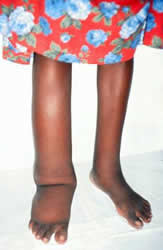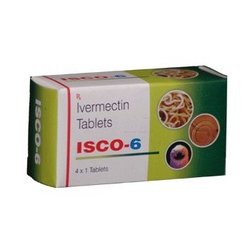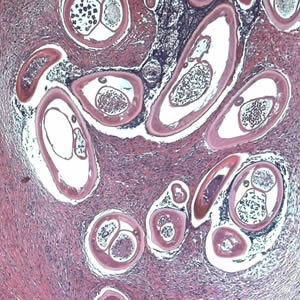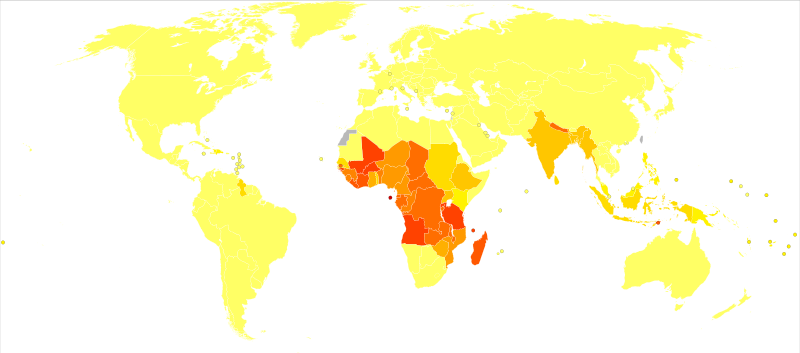Interactions
Horrif-EYE-ing symptoms!
The Loa loa is without a doubt a parasite in that the parasite
benefits while the host is harmed during the relationship; the
Loa loa benefits by feeding on bodily fluids underneath
the skin (Padgett and Jacobsen 2008). These parasites differ
from other thread-like
nematode parasites; they have nuclei
throughout their entire body while similar parasites do not have
their nuclei extend as far (Padgett and Jacobsen 2008). Learn
more about their morphology
and how it increases reproductive
success. A human infected with this parasite can experience
everything from no symptoms at all to spreading a disease called
filariasis, which can cause Calabar swelling (Padgett and
Jacobsen 2008). This swelling appears on the limbs and joints,
making the skin very irritated and movement painful (Padgett and
Jacobsen 2008). Another negative effect these parasites can
cause is extreme pain when migrating throughout the body tissues
(Padgett and Jacobsen 2008). This parasite rarely affects one’s
vision, however the inflammation as a result from the migration
of the parasite can cause temporary blindness that can endure
anywhere from a few minutes to a few hours (Padgett and Jacobsen
2008). Along with that, the Loa loa can mature in 1-4
years and can remain alive in your body for as long as 17 years!
(Padgett and Jacobsen 2008).
can experience
everything from no symptoms at all to spreading a disease called
filariasis, which can cause Calabar swelling (Padgett and
Jacobsen 2008). This swelling appears on the limbs and joints,
making the skin very irritated and movement painful (Padgett and
Jacobsen 2008). Another negative effect these parasites can
cause is extreme pain when migrating throughout the body tissues
(Padgett and Jacobsen 2008). This parasite rarely affects one’s
vision, however the inflammation as a result from the migration
of the parasite can cause temporary blindness that can endure
anywhere from a few minutes to a few hours (Padgett and Jacobsen
2008). Along with that, the Loa loa can mature in 1-4
years and can remain alive in your body for as long as 17 years!
(Padgett and Jacobsen 2008).
This could directly affect YOU!
How are these eye-soar suckers
spread?
The
life cycle of this nematode reveals just how they are
transmitted to humans- from the help of three different species
of Chrysops fly: Chrysops dimidiata, Chrysops
silacea, and
Chrysops langi (Padgett and Jacobsen
2008). Research does not indicate weather the larva of Loa
loa brings them any harm; they act more as a vessel to the
true destination: the human host. They generally inhabit
swampy areas with a body of water and a plentiful source of
decaying plant material (Padgett and Jacobsen 2008). Females
require a wet environment to lay their eggs as well as a blood
supply for energy and reproduction. These flies find their way
to humans because they are attracted to smoke from wood fire as
well as carbon dioxide we exhale (Padgett and Jacobsen 2008). It
all starts with a bite from one of these flies who carry the
developing larva of the Loa loa (Padgett and Jacobsen
2008). The bites from these flies differ from a puncture from a
mosquito; these flies create a slit then lap up the blood from
the host, which creates a pathway for the parasite to
enter (Padgett and Jacobsen 2008). When the larva enters the
human body, they must first be capable of crawling from the
mouth of the
fly into the bite (Padgett and Jacobsen 2008). They
mature under the skin of humans into the adult stages where the
fly will bite again and ingest the larva to carry it to another
human host (Padgett and Jacobsen 2008). From there, all it takes
is 12 days after exposure for these parasites to start to
develop (Antinori et al. 2012).
How do you get rid of these pests?
The most common methods of treating these parasites are surgical
extraction and antimicrobial drugs(Pagett and Jacobsen 2008).
The only problem with extraction is that it is tough to kill off
all traces of the parasite while the drugs are more effective in
that way (Pagett and Jacobsen 2008). However, some of the drugs
have negative side effects; in some cases when diethycarbamazine goes
through the blood stream, it causes brain swelling or
retinal seepage (Pagett and Jacobsen 2008). Ivermectin is the
most effective way to treat this infection yet it also has some
serious side effects: coma inducing, brain swelling, retinal
seepage, and kidney damage (Pagett and Jacobsen 2008). Research
suggest that there is a direct relationship between the
increased risk of
having a deadly reaction to ivermectin and the severity of the
infection or “population” of Loa loa (Gardon et al.
1997).
drugs are more effective in
that way (Pagett and Jacobsen 2008). However, some of the drugs
have negative side effects; in some cases when diethycarbamazine goes
through the blood stream, it causes brain swelling or
retinal seepage (Pagett and Jacobsen 2008). Ivermectin is the
most effective way to treat this infection yet it also has some
serious side effects: coma inducing, brain swelling, retinal
seepage, and kidney damage (Pagett and Jacobsen 2008). Research
suggest that there is a direct relationship between the
increased risk of
having a deadly reaction to ivermectin and the severity of the
infection or “population” of Loa loa (Gardon et al.
1997).
Parasite competition? Double trouble!
Onchocerca volvulus and Loa loa spell double the
trouble since they are prevalent in the same habitat and both cause human
filariases (Pagett and Jacobsen 2008). Additionally, treatment
through ivermectin therapy for patients who are infected with
both
Onchocerca volvulus and Loa loa is more risky because of the
neurological complications that can ensue from these treatments
(Pagett and Jacobsen 2008). The severe reactions to ivermectin are
not well understood; they may have to do with the rapid
effectiveness of the drugs killing the numerous larval parasites
(Pagett and Jacobsen 2008).
same habitat and both cause human
filariases (Pagett and Jacobsen 2008). Additionally, treatment
through ivermectin therapy for patients who are infected with
both
Onchocerca volvulus and Loa loa is more risky because of the
neurological complications that can ensue from these treatments
(Pagett and Jacobsen 2008). The severe reactions to ivermectin are
not well understood; they may have to do with the rapid
effectiveness of the drugs killing the numerous larval parasites
(Pagett and Jacobsen 2008).

